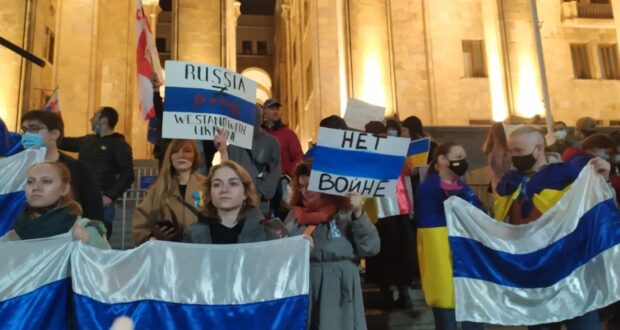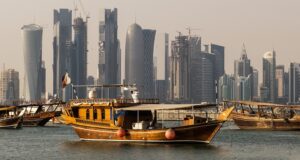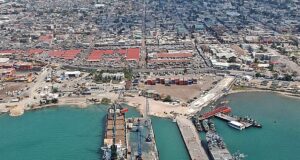June 23, 2022
By Oliver Hegglin – Research Assistant
Russia’s invasion of Ukraine on February 24 spawned protests in many countries with large Russian diasporas. It did not take long for an unknown horizontal white-blue-white flag to make its appearance side by side the Ukrainian flag at seemingly the same time in March in many of these protests. Soon this flag would become synonymous with the Russian anti-war movement and act as a symbol needed by Russians for the hopes of a free Russia of the future.
Claiming the Russian Federation’s current tri-color has become a symbol of war and aggression, the new flag is now supported by the Russian opposition movement, the Russian anti-war committee, and Russians within the Federation and abroad. In Bulgaria, Canada, Cyprus, Czechia, Georgia, Germany, Latvia, Lithuania, Norway, Poland, Russia, the USA, and surely other countries, the red-less flag has appeared as a way for Russians opposed to the war to stand apart from the Kremlin, as they feel unable to wave the official flag.
Origins
While no single individual is universally accredited with conceiving the design of the Free Russia flag, two individuals have shared the design on social media, leading to them being commonly acknowledged as being some of the first to popularize its design. Despite this, in interviews with both, they agree that the design is a “joint creation by the people”. The obvious difference between the current Russian state flag and the new design, is the omission of the bottom red stripe, which has become synonymous with the blood activists say the Kremlin is responsible for in this war.
The omission of the red stripe is a symbol of Russia without blood, war, and aggression. Promoters of the flag say the tri-color of the Russian Federation is now forever associated with war crimes and militarism. This flag itself was introduced by Tsarist Russia and omitting the red stripe is also seen as a way of ridding the country of imperialism and authoritarianism, both from the Tsarist era and under the current regime.
Coincidentally, the white-blue-white pattern does have some relation with Russia; It is recognizable as that of Russian police vehicles and the flag of the fictional country of Veyshnoria, created by Russia and Belarus during the 2017 Zapad military exercise. It also reference an earlier flag of the Russian city of Veliky Novgorod, the former capital of the medieval Novgorod Republic, commonly attributed with being the “cradle of Russian democracy”. Others might notice it is essentially identical to the flag of the Swiss Canton of Zug, though crucially, the pattern is not in use by any country as a national flag.
Similarities
It is argued that Novgoroder Russia, which existed from the 11th to 15th centuries, was the most democratic period in Russian history, though this “proto-democracy” was closer to an elected and limited oligarchy. The city today states it is also the birthplace of Russian Statehood, of Orthodox Russia, and of Literacy in Russia. The flag however, was only used by Veliky Novgorod, the city’s modern name, also just Novgorod, from 1994 to 2007 – there is apparently no confirmation of its historical use prior to that. Being one of the oldest cities in Russia, the Novgorod Republic did not have a flag in the modern sense, leading activists to adopt the colors used at the start of this century. The symbolism to medieval Novgorod then garnered the attention of Russians, who turned to the internet to discuss its significance and promote the flag.
The pattern also very closely resembles that of its Belarussian counterpart; white-red-white. Since disputed elections, protestors in Belarus have been using those colors, which originated from the short-lived Belarusian national republic in 1918. Both flags side-by-side show the mutual struggle those opposed to the existing regimes in Belarus and Russia find themselves in. The similarity and analogy with the white-red-white as a flag of protest and resistance has been listed as an advantage for the white-blue-white.
Significance
The symbolism behind the design of the white-blue-white has been spread throughout the internet and by word of mouth. While the omission of the red is perhaps the most obvious and visually distinctive feature, it is also argued that the blue of the current Russian state flag has been replaced with azure in the new flag. This color was visible on the Russian state flag from 1991 to 1993; a time of political instability when many Russians hoped for a better future and a path to democracy. By omitting the blue and replacing it with this azure, the Free Russia flag restores hope and faith of a better future. This color is also argued to be a symbol for truth and justice where the white represents peace, purity, and prudence, and recalls snow where the blue is the sky. There is, however, no internationally recognized shade of blue used by supporters of the flag. This permits anyone to reproduce the flag under any condition, using whatever colors and materials are at hand.
The flag may have more support and political significance than one might think, as protestors are not the only ones flying the white-blue-white. The “Freedom of Russia Legion”, also “Russian Legion”, a unit of the Ukrainian Armed Forces comprised of Russians, carries the white-blue-white on their uniforms, as opposed to the state flag used by the Russian Armed Forces. Rumored to have been founded when a Russian company crossed over to the Ukrainian side at the start of the war after realizing they had been misled and seeing the reality of the “special operation”, the Russian Legion was created to fight Putin’s regime. Now, Russian volunteers, deserters, and former prisoners of war, can volunteer for the Legion, after vetting by Ukrainian security services and counterintelligence. The Legion’s numbers are unknown, and it has allegedly begun to develop an underground resistance network within Russia, indicating the Free Russia flag is also being used as a symbol for resistance within the Federation. Besides on their uniforms, the Legion’s social media channels use the white-blue-white as well, in what is perhaps the most organized adoption of the flag to date. In so doing, the white-blue-white has arguably gained legitimacy as a potential candidate for state flag, even if this may not have been initially intended by supporters.
Legacy
The white-blue-white Free Russia flag, used widely in Russia and abroad, is becoming known as the flag of the “beautiful Russia of the future”. The flag is being produced as a pin, and the colors replicated as emojis. The flag is an opportunity for Russians opposing the war to regain some degree of self-identification, while showing the world many Russians oppose the actions of the Kremlin, which has proposed banning the flag as an “extremist” symbol. For the time being, there is no movement to insert it as a new Russian state flag; it is instead a symbol of Russians across the world joining together with hopes for peace and freedom. The flag frees Russians from the grasp of the Kremlin, permitting them to say “no” to the war and “no” to dictatorship.
Yet the flag is more than a symbol. The strong sentiments felt by Russians and others across the world against the war manifested from a design on the internet into a physical representation of a free and democratic Russia of the future. With groups such as the Russian Legion using the white-blue-white as its unit’s identifying patch, the prospect of a free Russia has now become an idea worth fighting for; something the Russian state now finds itself standing in opposition to its tri-color on the battlefield – something it likely fears. There may very well be a future in which the Free Russia flag, conceived collectively and simultaneously by Russians worldwide, may find itself flying atop the Kremlin.
Image: White-blue-white flag in Tbilisi, Georgia on 2 March 2022 (Source: Homo Paparaccis via CC BY-SA 4.0)
 Human Security Centre Human Rights and International Security Research
Human Security Centre Human Rights and International Security Research




